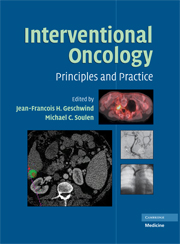Book contents
- Frontmatter
- Contents
- FOREWORD
- ACKNOWLEDGMENTS
- CONTRIBUTORS
- PART I PRINCIPLES OF ONCOLOGY
- PART II PRINCIPLES OF IMAGE-GUIDED THERAPIES
- PART III ORGAN-SPECIFIC CANCERS
- 9 Hepatocellular Carcinoma: Epidemiology, Pathology, Diagnosis and Screening
- 10 Staging Systems for Hepatocellular Carcinoma
- 11 Hepatocellular Carcinoma: Medical Management
- 12 Surgical Management (Resection)
- 13 Liver Transplantation for Hepatocellular Carcinoma
- 14 Image-guided Ablation of Hepatocellular Carcinoma
- 15 Embolization of Liver Tumors: Anatomy
- 16 Transcatheter Arterial Chemoembolization: Technique and Future Potential
- 17 New Concepts in Targeting and Imaging Liver Cancer
- 18 Intrahepatic Cholangiocarcinoma
- 19 Medical Management of Colorectal Liver Metastasis
- 20 Surgical Resection of Hepatic Metastases
- 21 Clinical Management of Patients with Colorectal Liver Metastasis Using Hepatic Arterial Infusion
- 22 Colorectal Metastases: Ablation
- 23 Colorectal Metastases: Chemoembolization
- 24 Radioembolization with 90Yttrium Microspheres for Colorectal Liver Metastases
- 25 Carcinoid and Related Neuroendocrine Tumors
- 26 Interventional Radiology for the Treatment of Liver Metastases from Neuroendocrine Tumors
- 27 Immunoembolization for Melanoma
- 28 Preoperative Portal Vein Embolization
- 29 Cancer of the Extrahepatic Bile Ducts and the Gallbladder: Surgical Management
- 30 Extrahepatic Biliary Cancer: High Dose Rate Brachytherapy and Photodynamic Therapy
- 31 Extrahepatic Biliary Cancer/Biliary Drainage
- 32 Surgical and Medical Treatment
- 33 Percutaneous Renal Ablation
- 34 Embolotherapy in the Management of Renal Cell Carcinoma
- 35 Epidemiology, Diagnosis, Staging and the Medical-Surgical Management of Lung Cancers
- 36 Image-guided Ablation in the Thorax
- 37 Interventional Treatment Methods for Unresectable Lung Tumors
- 38 Interventional Neuroradiology in Head and Neck Oncology
- 39 Percutaneous Ablation of Painful Metastases Involving Bone
- 40 Intra-arterial Therapy for Sarcomas
- 41 Prostate Cryoablation: A Role for the Radiologist in Treating Prostate Cancer?
- PART IV SPECIALIZED INTERVENTIONAL TECHNIQUES IN CANCER CARE
- INDEX
- Plate section
- References
9 - Hepatocellular Carcinoma: Epidemiology, Pathology, Diagnosis and Screening
from PART III - ORGAN-SPECIFIC CANCERS
Published online by Cambridge University Press: 18 May 2010
- Frontmatter
- Contents
- FOREWORD
- ACKNOWLEDGMENTS
- CONTRIBUTORS
- PART I PRINCIPLES OF ONCOLOGY
- PART II PRINCIPLES OF IMAGE-GUIDED THERAPIES
- PART III ORGAN-SPECIFIC CANCERS
- 9 Hepatocellular Carcinoma: Epidemiology, Pathology, Diagnosis and Screening
- 10 Staging Systems for Hepatocellular Carcinoma
- 11 Hepatocellular Carcinoma: Medical Management
- 12 Surgical Management (Resection)
- 13 Liver Transplantation for Hepatocellular Carcinoma
- 14 Image-guided Ablation of Hepatocellular Carcinoma
- 15 Embolization of Liver Tumors: Anatomy
- 16 Transcatheter Arterial Chemoembolization: Technique and Future Potential
- 17 New Concepts in Targeting and Imaging Liver Cancer
- 18 Intrahepatic Cholangiocarcinoma
- 19 Medical Management of Colorectal Liver Metastasis
- 20 Surgical Resection of Hepatic Metastases
- 21 Clinical Management of Patients with Colorectal Liver Metastasis Using Hepatic Arterial Infusion
- 22 Colorectal Metastases: Ablation
- 23 Colorectal Metastases: Chemoembolization
- 24 Radioembolization with 90Yttrium Microspheres for Colorectal Liver Metastases
- 25 Carcinoid and Related Neuroendocrine Tumors
- 26 Interventional Radiology for the Treatment of Liver Metastases from Neuroendocrine Tumors
- 27 Immunoembolization for Melanoma
- 28 Preoperative Portal Vein Embolization
- 29 Cancer of the Extrahepatic Bile Ducts and the Gallbladder: Surgical Management
- 30 Extrahepatic Biliary Cancer: High Dose Rate Brachytherapy and Photodynamic Therapy
- 31 Extrahepatic Biliary Cancer/Biliary Drainage
- 32 Surgical and Medical Treatment
- 33 Percutaneous Renal Ablation
- 34 Embolotherapy in the Management of Renal Cell Carcinoma
- 35 Epidemiology, Diagnosis, Staging and the Medical-Surgical Management of Lung Cancers
- 36 Image-guided Ablation in the Thorax
- 37 Interventional Treatment Methods for Unresectable Lung Tumors
- 38 Interventional Neuroradiology in Head and Neck Oncology
- 39 Percutaneous Ablation of Painful Metastases Involving Bone
- 40 Intra-arterial Therapy for Sarcomas
- 41 Prostate Cryoablation: A Role for the Radiologist in Treating Prostate Cancer?
- PART IV SPECIALIZED INTERVENTIONAL TECHNIQUES IN CANCER CARE
- INDEX
- Plate section
- References
Summary
Hepatocellular carcinoma (HCC) is a major public health problem. Although initially thought of as a disease of the developing world, particularly sub-Saharan Africa and the Far East, it is now recognized to be of growing importance in the United States, Europe, Russia and Japan, mainly in relation to the increasing prevalence of chronic hepatitis C virus infection.
EPIDEMIOLOGY, RISK FACTORS AND PREVENTION
HCC is said to be the fifth most common cancer worldwide, and the third most common cause of cancer-related mortality (1), but these are likely to be underestimates because of underreporting in developing countries. The highest annual incidence rates, of around 100 per 100,000, occur in parts of southern Africa and the Far East (1), and as such, these areas account of at least 75% of all cases. In contrast, HCC is less common in northern Europe, the United States and Australia, although there is evidence that the frequency may be increasing, most likely in relation to the spread of chronic hepatitis C virus infection (2). HCC usually arises in a diseased liver, usually at the stage of cirrhosis, and in this setting it is predominately a disease of men. The cirrhosis is not always symptomatic, and the development of HCC may be the first indication of the underlying cirrhosis (3, 4). HCC is now one of the leading causes of death in patients with cirrhosis. In most populations, the incidence increases with age, but the mean age tends to be lower in high-incidence areas.
- Type
- Chapter
- Information
- Interventional OncologyPrinciples and Practice, pp. 101 - 106Publisher: Cambridge University PressPrint publication year: 2008



